Looking for a new way to spice up your cooking? My satay sauce recipe with peanuts will definitely do the trick! This recipe uses real peanuts and makes a delicious satay sauce made from scratch! It combines the rich flavors of peanuts, lemongrass, and galangal, enhanced by the tangy taste of tamarind and lime juice, and the sweetness of palm sugar. Roasting the peanuts gives an extra nutty flavor, making this recipe a real standout.
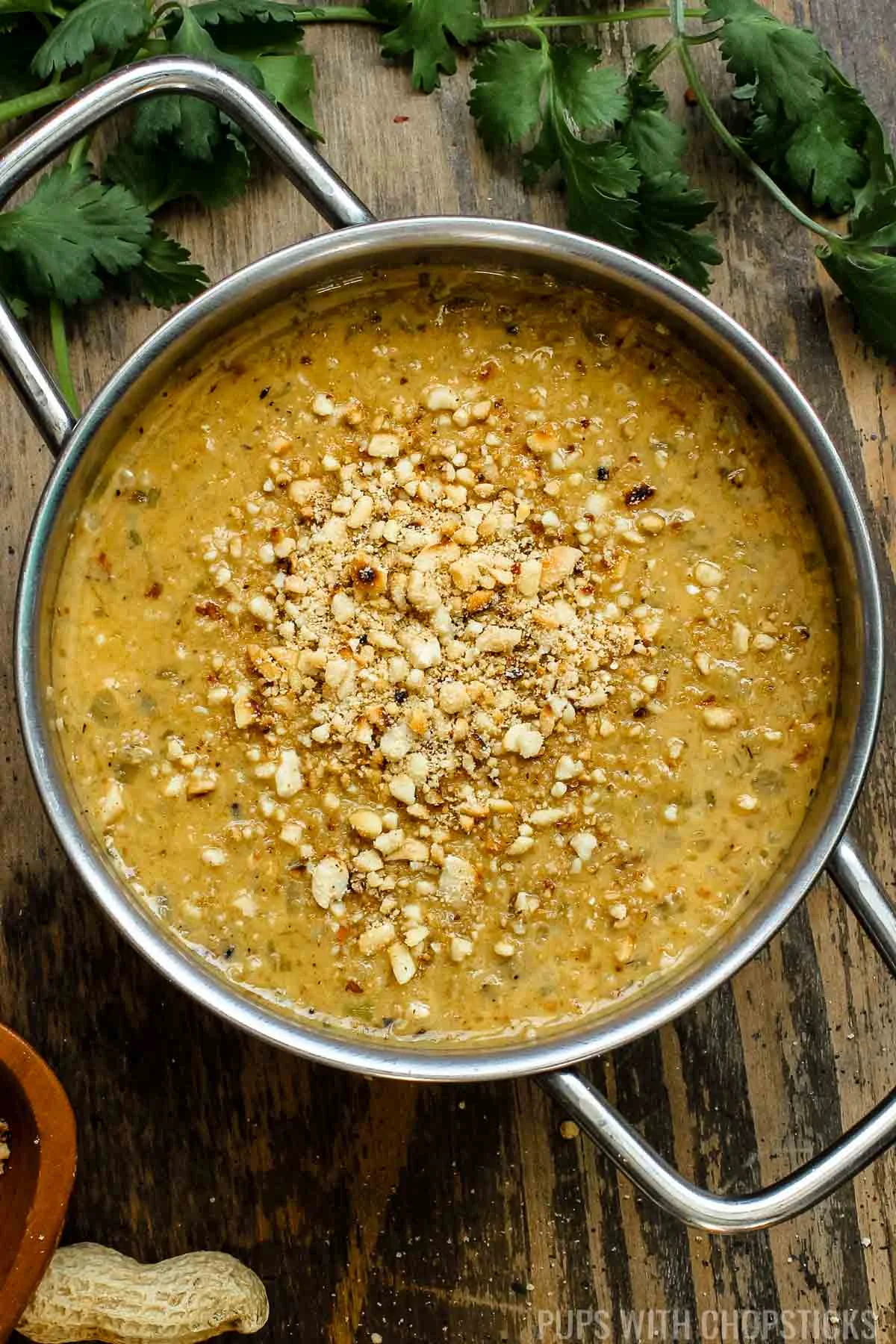
Satay sauce is a staple in many Thai dishes, providing a rich, nutty, and slightly spicy taste that pairs well with chicken, tofu, and even vegetables. Making it at home allows you to control the ingredients and flavors, making sure you get the perfect balance of sweet, sour, and spicy to suit your taste.
This recipe is special because it teaches you to make authentic Thai satay sauce from scratch, using traditional ingredients like lemongrass, galangal, and palm sugar. Once you try this homemade version, you’ll never want to go back to store-bought again!
If you're pressed for time, I also have a quick and easy peanut satay sauce recipe that you can try as well.
Read on to learn exactly how to make this delicious satay sauce with peanuts recipe today!
What is Satay Sauce with Peanuts?
Satay sauce is a staple in Thai cuisine and features a delicious combination of rich, savory, sweet and slightly spicy flavors all in one! This recipe uses peanuts to make the recipe from scratch. You’ll end up with the tastiest satay sauce you’ve ever had. And it’s pretty simple to make, too.
You must be wondering why bother making a satay sauce with peanuts. The main reason is flavor and texture. The extra ingredients and steps give this Thai peanut sauce more dimension and flavor. It’s definitely worth the extra effort, trust me!
Plus, it’s super versatile. It’s not just for satays! You can drizzle some on cold noodles with veggies or just freeze it in an ice cube tray to use another day. Reheat it in a low heat pan and you can use the sauce right away!
This recipe is the best way to make satay sauce with peanuts, trust me! You’re going to fall in love with the flavors! So, whether you’re a seasoned cook or a kitchen newbie, this satay sauce recipe with peanuts is worth a try.
Why You’ll Love This Satay Sauce Recipe with Peanuts
Easy to Make: This satay sauce recipe with peanuts has a very simple cooking process. The step-by-step instructions guide you through the process of roasting the peanuts, preparing the tamarind pulp, and making the sauce, guaranteeing a hassle-free cooking experience.
Versatile: This recipe is highly adaptable to accommodate individual taste preferences. Whether you prefer a smooth or chunky texture or want to adjust the flavor balance by tweaking the lime juice, sugar, or fish sauce, this recipe allows for plenty of customization.
Delicious and Authentic: The combination of ingredients like lemongrass, galangal, garlic, shallots, and tamarind pulp results in a unique blend of flavors that tastes incredible. Plus, the toasted peanuts add a crunchy texture and nutty flavor that elevates the taste of the satay sauce.
Crowd Pleaser: This satay sauce is a universal favorite. Thanks to its rich and aromatic flavors, it pairs well with a variety of dishes, from skewered meats to stir-fry dishes and noodles, making it a hit at any gathering.
Healthy Option: This recipe uses natural ingredients like peanuts, lemongrass, galangal, and tamarind, which are known for their health benefits. It also omits the use of any artificial additives, making it a healthier choice for a sauce.
Ingredients You’ll Need to Make Satay Sauce with Peanuts At Home
All you need are some incredibly simple, pantry-staple ingredients to make this delicious peanut dipping sauce recipe at home.
Here's an overview of the specific ingredients for this recipe. For the exact ingredients and measurements, please scroll to the recipe card below.
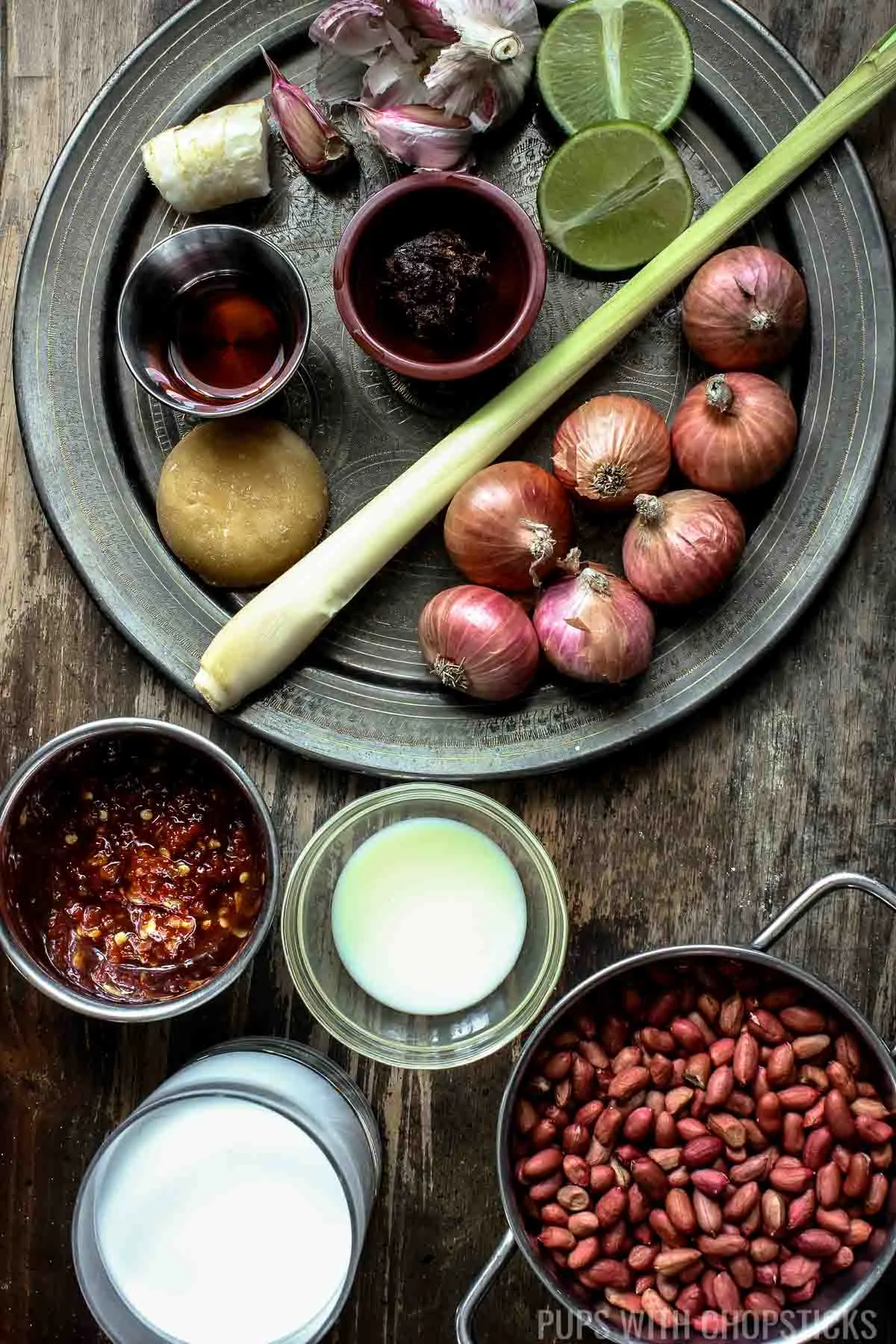
- Peanuts: We’ll need unsalted, skinless peanuts. The peanuts will form the base of your satay sauce, providing a rich, nutty flavor and a satisfying crunch, especially if you opt for a chunky sauce. If you can't find skinless peanuts, it's okay, I'll show you how to remove the skins after you toast them.
- Lemongrass: Lemongrass will add a unique citrusy flavor to the sauce, complimenting the sweetness of the palm sugar and the spiciness of the chilies.
- Galangal: It will infuse the satay sauce with a sharp, pine flavor. Although galangal and ginger come from the same family they taste quite different. Ginger has a much stronger spicy floral flavour so do not use it as an substitute. If you cannot find galangal, you can omit it.
- Garlic: Garlic will add a garlicky flavor to the sauce, enhancing the overall flavor profile.
- Shallots: They will add a mild, sweet, and slight onion flavor to your satay sauce, complimenting the other ingredients nicely.
- Tamarind Pulp: This will add a tangy, slightly sweet flavor to the sauce. If you are using tamarind pulp, you will need to add some hot water to reconstitute it and strain out the seeds, skins, and pulp before you use it. If you are using tamarind paste (from a jar), make sure you are using ones from made in Thailand instead of ones from India. Tamarind concentrate from India is a lot stronger and sour than the ones from Thailand.
- Coconut Milk: This will give your satay sauce a creamy, rich texture and a subtle tropical flavor.
- Palm Sugar: Palm sugar will add a natural sweetness to the satay sauce, complementing the spiciness of the chilies and the tanginess of the tamarind and lime juice. Palm sugar may be a tricky thing to find, but it can be found in Asian grocery stores. If you must substitute it, just remember that palm sugar isn't as sweet as conventional sugars and it also provides a creaminess as well. I would substitute it with brown sugar if you cannot find it.
- Lime Juice: It will brighten up the flavors of the satay sauce, adding a refreshing sourness that balances the sweetness of the palm sugar. Use fresh lime juice from limes and not the bottled stuff for the best flavor.
- Fish Sauce: Fish sauce will add a robust, savory depth to your satay sauce.
- Birds Eye Chili: These chilies will give your satay sauce a fiery kick, but you can adjust the quantity according to your spice tolerance. Start with 2 and work your way up. I don't always have this on hand so I sometimes cheat and just use a chili hot sauce like sriracha in place of the chili peppers
How to Make Satay Sauce Recipe with Peanuts (Step by Step)
Making this incredible peanut sauce recipe at home is super easy and will give you great results every single time. Here's how to make it step by step:
Roasting the Peanuts
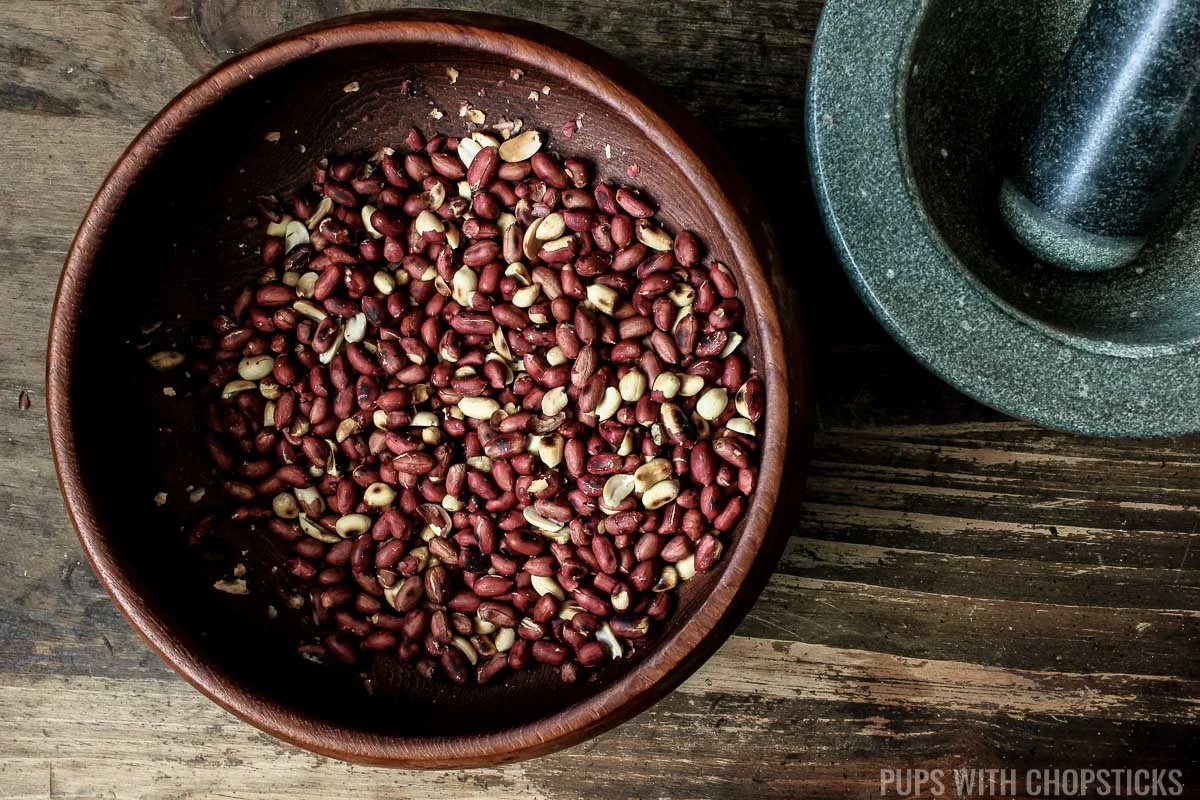
Let’s start by roasting the peanuts. If your peanuts are already peeled, you can roast them directly in the pan. To do this, place them in a frying pan and roast until they turn a toasty brown hue. This process enhances their flavors by releasing the oils within them.
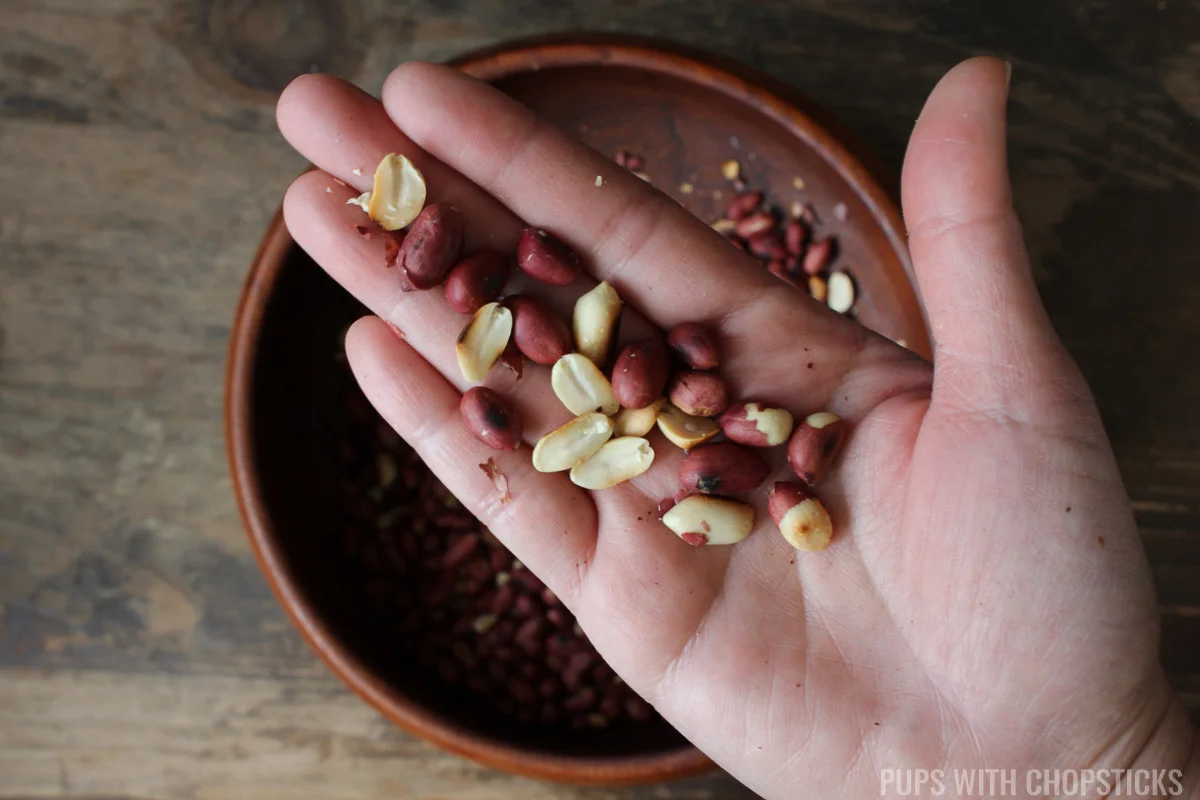
However, if you have purchased shelled peanuts, or skinned peanuts you’ll need to take an extra step. After shelling them, toast them with the skin on. After toasting, allow the peanuts to cool. The peanut skins will crack and the peanuts will shrink slightly so it is very easy to remove the skins by rubbing them between your palms or fingers to remove the skin.
After the peanuts have cooled, the next step is to crush them finely. You can use a mortar and pestle for this step. If you don’t own a mortar and pestle, don’t worry! You can achieve a similar result by giving them a quick pulse in a food processor, or by chopping them finely by hand. Remember to reserve 1-2 tablespoons of the crushed peanuts - these will be used later as a garnish.
Making the Sauce
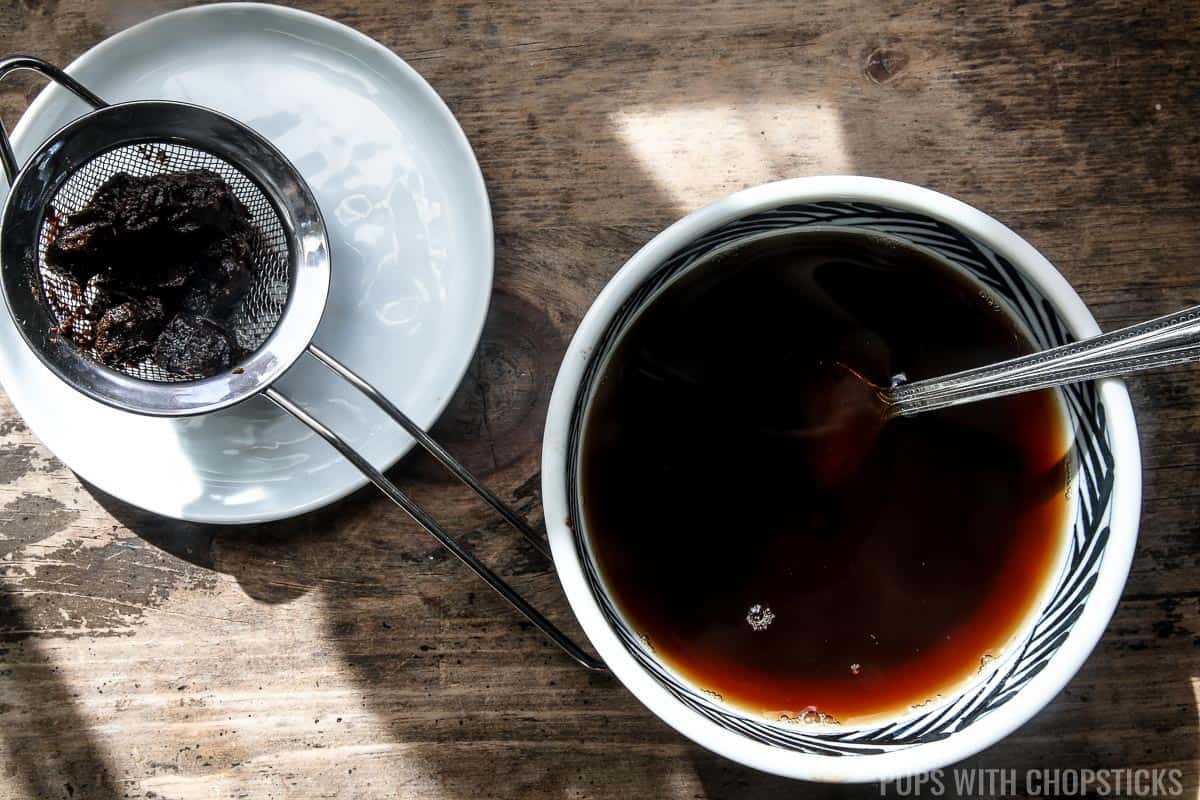
Now that the peanuts are prepared, let’s move on to making the sauce. Begin by soaking the tamarind pulp in about 3-4 tablespoons of water for a few minutes, then strain out the seeds and skins. If you are using tamarind paste from a jar, you can skip this step and use it directly from the jar.
Next, chop up the galangal, garlic, lemongrass, and shallots, and place them in a food processor. Pulse the ingredients until they form an almost paste-like consistency. If you don’t have a food processor, finely chop these ingredients by hand. The finer the chop, the smoother your sauce will be.
Heat some oil in a pan over medium heat. Add the lemongrass, shallot, garlic, and galangal mixture, and sauté until browned. Next, add in the chopped bird’s eye chili, and continue to cook for a few more minutes.
Now, turn down the heat to low and add in the coconut milk, fish sauce, tamarind water, lime juice, and water. Stir these ingredients together until they’re well combined. Then, add in the palm sugar and your crushed roasted peanuts, and let the mixture simmer gently for the next 10-15 minutes.
If at any point you find the sauce too thick, feel free to add more water to thin it out. Finally, give the sauce a taste and adjust the flavor as needed. Everyone’s taste buds are different, and you may prefer your satay sauce to be more salty, sweet, or sour. You can tweak the flavor by adding more lime juice, sugar, or fish sauce until it is just right for you.
Your Satay Sauce with Peanuts is ready to serve! This robust, flavorful sauce is not only versatile but also a delightful blend of Thai taste and texture. Enjoy!
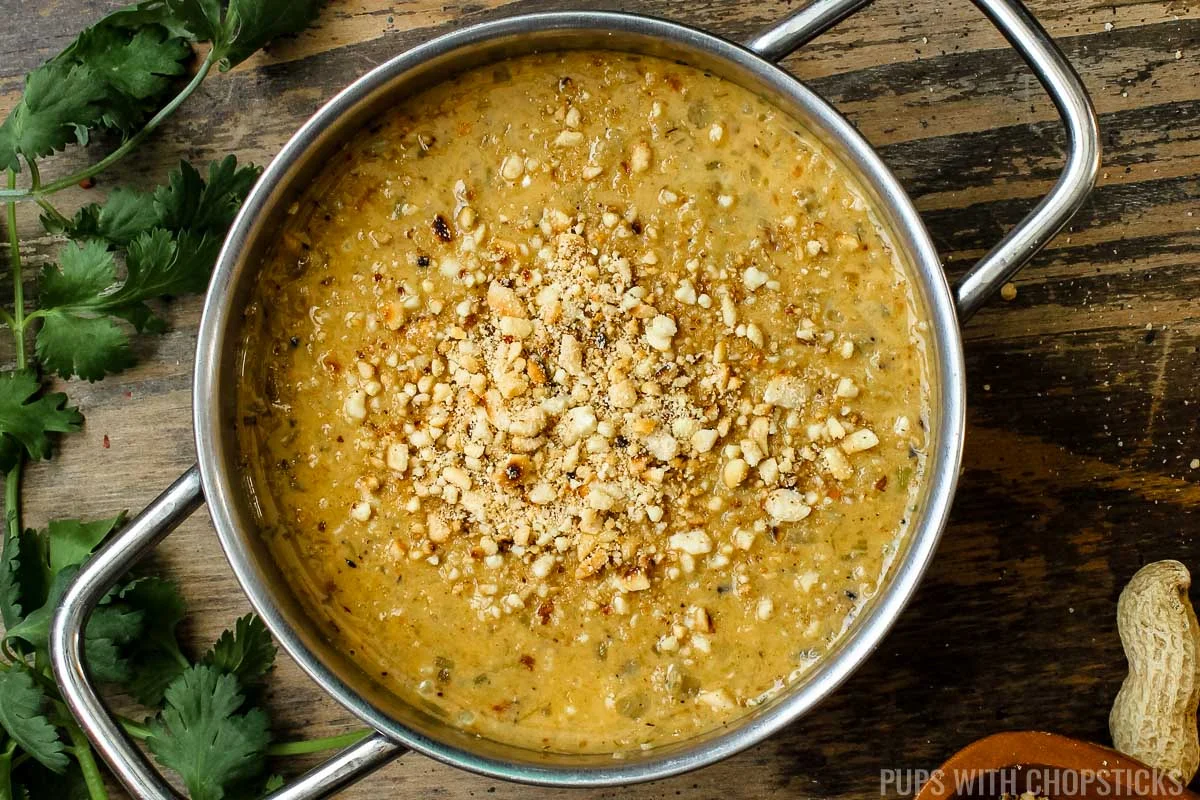
Joyce's Tips For Making the Best Satay Sauce Recipe with Peanuts Every Single Time
Roast the Peanuts: It's very important to roast your peanuts before you use them in the sauce because it gives it so much more flavor. When roasting peanuts, make sure to keep an eye on them as they can burn quickly. Stir them occasionally for an even roast.
Preparing the Tamarind Pulp: Soaking the tamarind pulp in hot water helps to soften it and makes it easier to strain out the seeds and skins. Soak it for at least 15 minutes and then strain it out the seeds pods and skin.
Balancing the Flavors: The taste of satay sauce comes from the balance between sweet, sour, and salty flavors. Don’t be afraid to adjust the sauce to your liking by adding more lime juice, palm sugar, or fish sauce. This is your sauce, so make it taste how you like!
Do Not Substitute Ginger for the Galangal: Although galangal and ginger come from the same family, they have a very different taste. For an authentic Thai flavor, it is better to use galangal. If you can’t find it, it is better to omit it from the recipe rather than substituting it with ginger.
How To Use Palm Sugar: This usually comes in small hard blocks. If it's too hard to work with, you can microwave it a few seconds a time to soften it before you start to cut it with a knife. If you can't find palm sugar, you can substitute it with light brown sugar.
Not All Tamarind Paste Is The Same: If you’re using tamarind paste from a jar instead of tamarind pulp, make sure you are buying the ones from Thailand only. Tamarind paste from India is much stronger and potent and very sour, it will overpower the entire sauce.
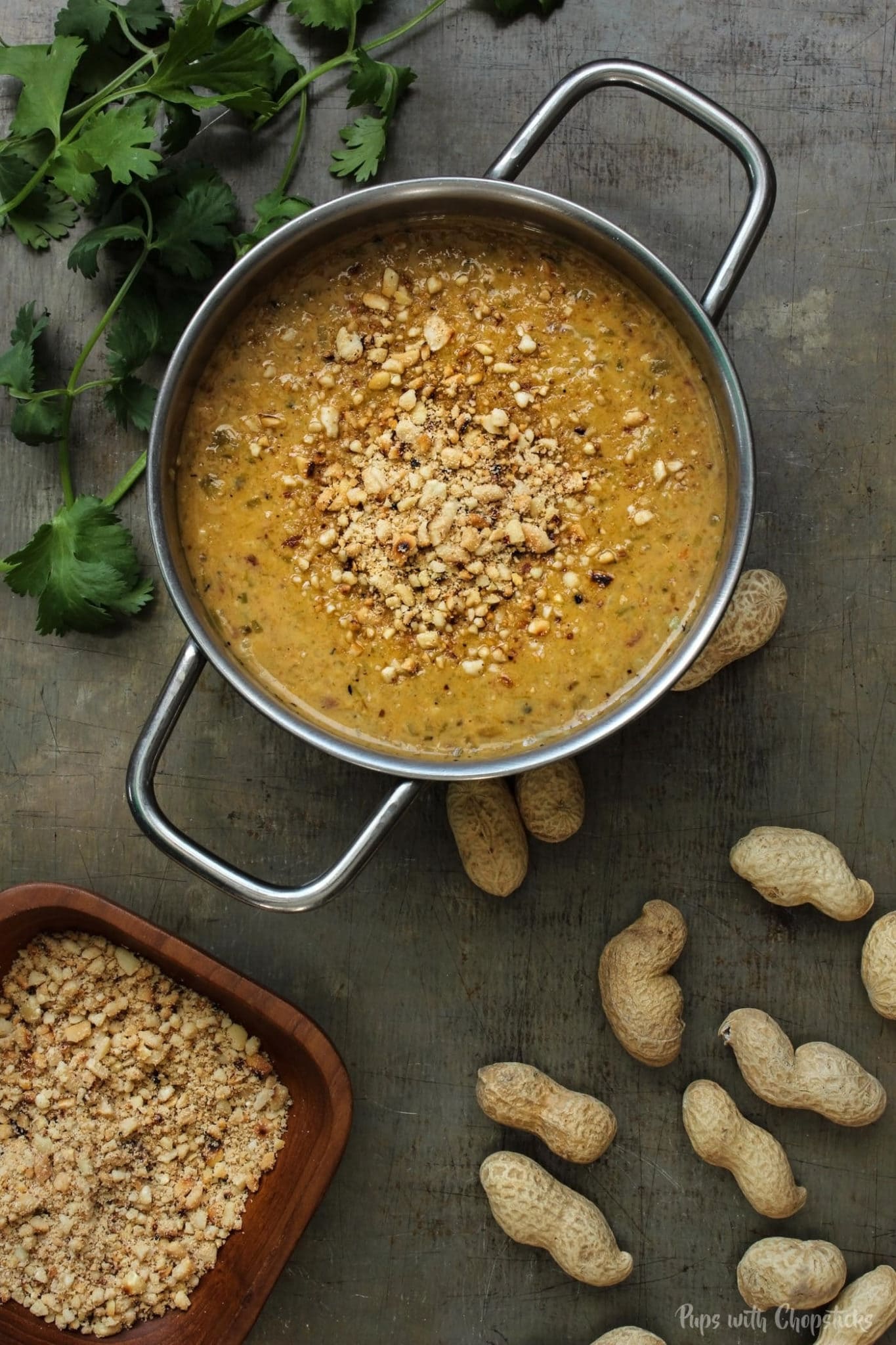
Serving Suggestions
- Easy Grilled Thai Chicken Skewers: This satay sauce with peanuts pairs excellently with grilled Thai chicken skewers. The complex flavors of the sauce compliment the smoky, grilled taste of the chicken, making it a meal to remember. Add a side of jasmine rice for a complete Thai experience.
- Chicken Satay Recipe with Peanut Sauce: Serve this satay sauce as a dip with chicken satay for a traditional Thai treat. The sauce’s rich, nutty flavor enhances the marinade of the chicken satay, creating a dish bursting with taste.
- Grilled Thai Curry Chicken Wings: Try this sauce as a marinade for grilled Thai curry chicken wings. The spicy, sweet and tangy elements of the sauce blend perfectly with the chicken wings, making it a hit at any gathering.
- Stir-fried Noodles: This satay sauce can also be tossed with stir-fried noodles. The peanuts and spices in the sauce add depth and texture to the noodles, transforming a simple dish into a real treat!
- Tofu Satay: For a vegetarian option, serve this satay sauce with tofu satay. The tofu’s mild flavor allows the vibrant taste of the sauce to shine through, providing a satisfying meal for those avoiding meat.
- Fresh Salads: Add some of this delicious satay sauce with peanuts into your favorite salad or have it on the side with some fresh spring rolls, or your favorite stir fry. This sauce is super versatile and works great with just about everything!
Recipe Variation Ideas for Satay Sauce with Peanuts
This delicious satay sauce with peanuts recipe is so flavorful and easy to make, you'll want to try out some of these delicious variations! Here are some great ideas:
Sweet and Tangy: For a sweet and tangy twist, add a bit more tamarind pulp and increase the amount of palm sugar. This will give your satay sauce a delightful sweet and sour flavor that pairs perfectly with grilled chicken or tofu.
Soy-Free: If you’re looking for a soy-free alternative, replace the soy sauce with coconut aminos. This will still provide a savory, sweet, and salty flavor to your satay sauce but without the gluten or soy.
Spicy Kick: If you love a bit of heat, add an extra birds eye chili or two into your sauce. This will give your satay sauce a fiery kick that will tantalize your taste buds. Remember to balance the heat with a bit more palm sugar or lime juice. Alternatively, you can also add sriracha as well.
Frequently Asked Questions
While ginger and galangal come from the same family, they have very distinctintly different flavors. If you don’t have galangal, you can omit it from the recipe instead of substituting it with ginger.
Everyone’s preference for peanut sauce varies. To make it more sour, add more lime juice. If you want it sweeter, add condensed milk. For a more savory flavor, add extra fish sauce.
Yes, if you prefer a smoother sauce, you can pulse the mixture in a food processor until it achieves the desired smoothness.
Yes you can, just make sure the tamarind paste comes from Thailand because tamarind paste from India is very potent and strong and will overpower the sauce.
I also have an article that go into more details about the difference between tamarind paste vs tamarind pulp.
Unsalted, skinless peanuts are recommended for this recipe. However, if you bought shelled peanuts, you can shell and toast them with the skin on, then rub the peanuts between your palms to remove the skin once they cool.
How to Store Leftover Satay Sauce with Peanuts
To store this hearty sauce in the fridge, first, let it cool down to room temperature. Once cooled, transfer the sauce into an airtight container. It can be stored in the fridge for up to a week. The flavors may intensify over time, enhancing the taste even more.
When it comes to reheating, you can heat the sauce in a microwave-safe bowl for about 1 minute or on a stovetop in a small saucepan over low heat. Stir the sauce occasionally to make sure that it warms evenly.
Add a splash of water if it seems too thick, or tweak the flavor to your liking. You can add lime juice to make it more sour, condensed milk to sweeten it, or more fish sauce for a savory kick.
If you have a generous amount of leftover satay sauce, freezing is another great option for longer storage. To freeze, pour the cooled sauce into a freezer-safe container or zip-top bag. It can be stored in the freezer for up to three months.
Thawing the frozen satay sauce is easy – simply transfer it into the fridge 24 hours before you plan to use it. Reheat as instructed above.
Recipes To Use Up Leftover Tamarind Paste
More Thai Recipes You May Like
- Pad Thai
- Thai Basil Chicken (Pad Kra Pao)
- Tom Kha Gai (Thai Coconut Soup)
- Khao Soi
- Thai Red Curry
- Pad Woon Sen (Thai Glass Noodle Stir Fry)
- Grilled Coconut Chicken Skewers
- Tom Yum Soup
- Thai Peanut Noodles
Did You Make This Recipe?
If you made this Thai satay peanut sauce recipe (made from scratch), I want to see! Follow Pups with Chopsticks on Instagram, snap a photo, and tag and hashtag it with @pupswithchopsticks and #pupswithchopsticks. I love to know what you are making!
Please also consider leaving a ⭐⭐⭐⭐⭐ rating and a comment to tell me how it went! I'd love to hear from you if you made this!
If you like my recipes and want to be updated on when new ones come out, please consider subscribing to my newsletter (we don't spam) and follow along on Instagram, Facebook, and Pinterest for all of my latest recipes!
Recipe Card
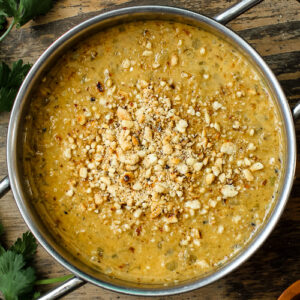
Thai Satay Peanut Sauce (Made from Scratch with Peanuts)
Joyce's Recipe Notes
- Although galangal and ginger come from the same family they taste very different. Do not substitute the galangal for ginger if you don't have it. Omit the galangal from the recipe instead
- Everyone's preference is always different when it comes to peanut sauce. Tweak it until it's perfect for you. To make it more sour, use some lime juice. To make it more sweet, use some condensed milk. To make it more savoury, add some more fish sauce.
- Smooth or Chunky? This recipe will produces a hearty chunk sauce with peanut bits but if you enjoy a smoother sauce you can just throw it in the food processor and blitz it! ?
- If you’re using tamarind paste from a jar instead of tamarind pulp, make sure you are buying the ones from Thailand only. Tamarind paste from India is much stronger and potent and very sour, it will overpower the entire sauce.
- If your palm sugar is too hard, microwave it for a few seconds at a time before you cut it with a knife.
- If you can't find palm sugar, you can substitute it with light brown sugar.
Ingredients
- 1 cup peanuts (unsalted, skinless)
- 1 stalk lemongrass (approx. ¼ cup, finely chopped)
- 1 tablespoon galangal (approx. 3x3 cm)
- 1 tablespoon garlic (2 cloves)
- ¼ cup shallots (3 small shallots)
- 2-3 birds eye chili (finely chopped)
- 1 cup coconut milk
- ¼ cup palm sugar (or 3 tablespoons of light brown sugar)
- ¾ cup water (add more if you prefer a thinner sauce)
- 2-3 tablespoons fish sauce
- 1 tablespoon lime juice (approx. ½ lime)
Tamarind Pulp
- 2 teaspoon tamarind pulp (seeds and pulp removed. If you are using tamarind paste from a jar, use 3 tablespoons)
- 3-4 boiling water
Topping
- unsalted raw peanuts (roasted and finely crushed)
Instructions
Roast the Peanuts
- If you bought peanuts without the skin, place them in a frying pan over medium-low heat and give them a quick roast until they are toasty and brown. Remember to shake the pan every few minutes to them moving so that they don't burn. They take about 10 minutes.
- If you bought shelled peanuts, or peanuts with the skin on, shell them and toast them in a frying pan over medium-low heat for about 10 minutes. Shake the pan every few minutes to prevent them from burning. This takes about 10 minutes.Once the peanuts have finished roasting, let it cool. The skins should be cracked and the peanuts would have shrunk slightly which makes it easier to remove the skins by rubbing them between your palms or fingers.
- Once the peanuts have finished roasting, let them cool a bit. Then in a mortar and pestle crush the peanuts up finely. If you don’t have a mortar and pestle, you can pulse it in a food processor (pulse a few times until peanuts are in smaller pieces, do not blend it because that will make peanut butter.) Alternatively, you can also hand chop it finely.
- Reserve 1-2 tablespoons of the finely crushed peanuts as a topping
Prepare the Tamarind Pulp
- Soak 2 teaspoon tamarind pulp in a 3-4 tablespoons of boiling water for 15 to 30 minutes minutes and then strain out the seeds and skins. Save the tamarind water for the sauce, there should be about 3 tablespoons.If you are using tamarind paste from a jar, you can skip this step.
Making the Sauce
- Chop up the galangal, garlic, lemongrass and shallots and put them into a food processor and blitz it to it is almost a paste. If you don’t have a food processor you can chop them by hand but chop them up finely. The finer the chop the less chunks in the sauce.
- In a pan, add some oil onto medium heat and brown the lemongrass, shallot, garlic galangal mixture.
- Add in the chopped birds eye chili and continue to cook it in the pan for a few minutes.
- Turn down the stove to low heat and add in 1 cup coconut milk, 2-3 tablespoons fish sauce, tamarind water (or tamarind paste), 1 tablespoon lime juice, and ¾ cup water and stir until combined.
- Add ¼ cup palm sugar and crushed peanuts and continue to cook for 10-15 minutes
- If you find the sauce too thick, add some more water to thin it out.
- Taste it and adjust the flavour. Is it salty, sweet or sour enough for you? Everyone has a different preference on how they enjoy peanut sauce. Adjust accordingly by tweaking it with lime juice, sugar or fish sauce.
Nutrition
*Nutritional information is calculated using online tools and is an estimate*
Disclaimer: We are a participant in the Amazon Services LLC Associates Program, an affiliate advertising program designed to provide a means for us to earn fees by linking to Amazon.com and affiliated sites, however I provide these links to make items easier to find if you cannot purchase this locally and I would never recommend anything I don’t own myself or highly recommend. I would prefer you buy your items locally if possible to support your local shops (and chances are they are cheaper locally as well!)

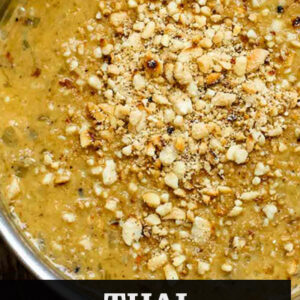
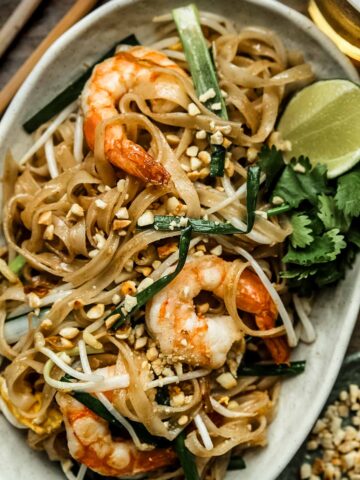
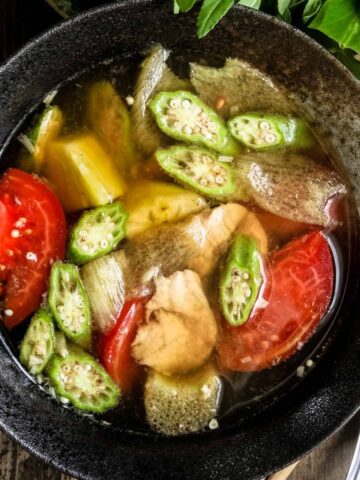
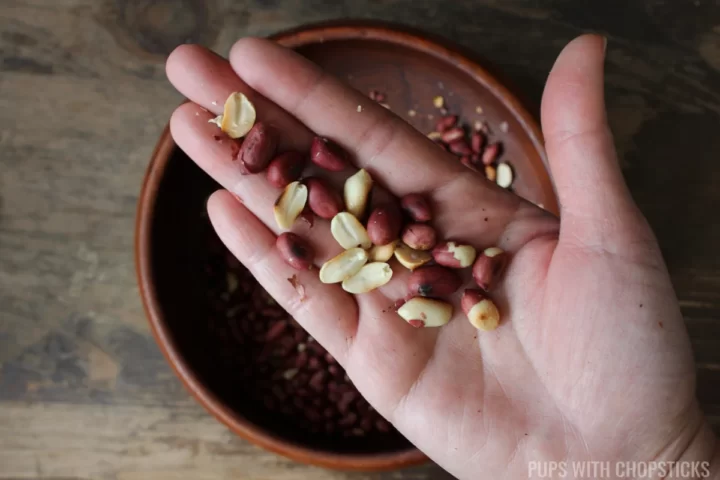
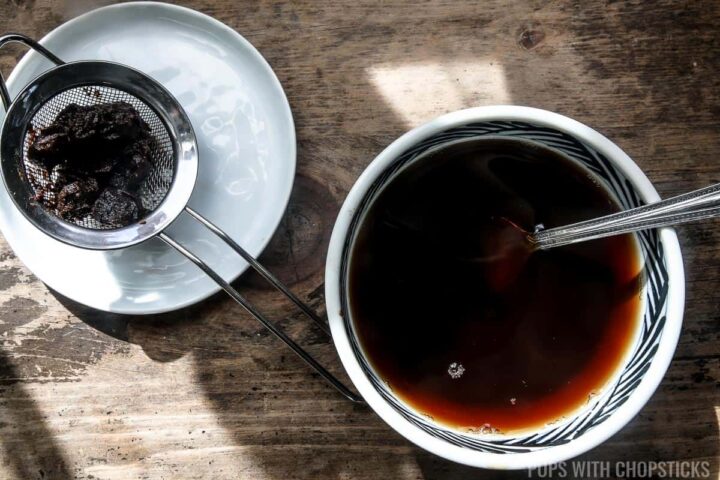

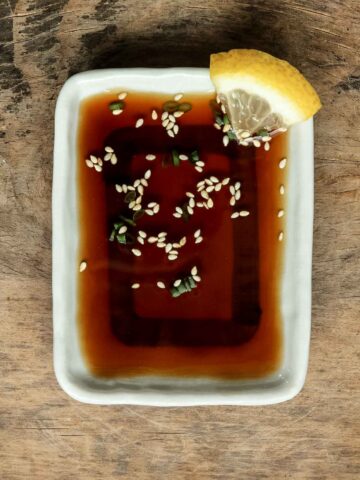
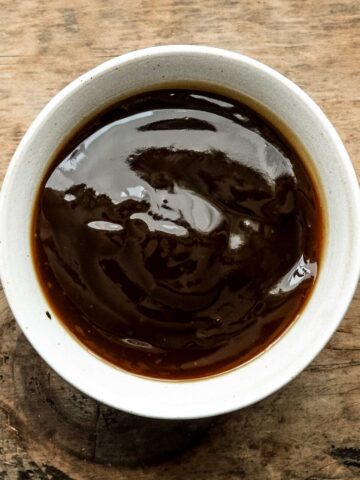
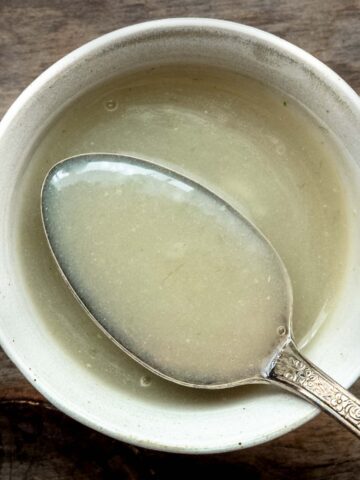
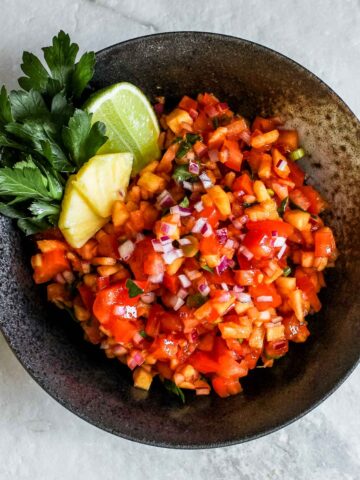
Cheryl says
Hi, thank you for this recipe. This is just what I've been looking for. Many other recipes use peanut butter.
But I want to know what the shelf life of this sauce is or refrigerator life?
Joyce says
Hi Cheryl,
I usually can keep this in the fridge for up to a week, I have stretched it to a week and a half - but you have to keep it in the refrigerator when you are not using it. Hope this helps! 🙂
Ta says
So I soaked my tamarind as instructed...but where do I add it? I've read this through eight times and cannot see what or where. Please and thank you!
Joyce says
Hi Ta!
Good catch! I totally missed that! You should put the tamerind water in with the rest of the ingredients on step 5 under 'Making the Sauce'. I will add the missing instructions now! 🙂
Ginny says
Peanut Sauce is one of my favorite things and you've made this amazing recipe for it. Thank you!
Liz says
I love making peanut sauce! It's such a great way to flavor pretty much any kind of stir fry!
Sarah says
Scratchmade recipes just make life better, am I right? Especially when they're for one of my favorite sauces! Can't wait to make this!
Deanna says
LOVE! The satay peanut sauce!! This looks amazing!
Savita @ ChefDeHome says
I'm super fan of Satay Sauce. Yumm! So delicious!